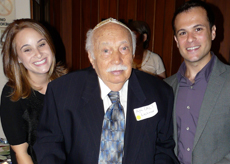
By CARLY GERBER
JUF News
Posted: 12/23/2014 11:03:20 AM
The smell of fresh brew and the sounds of friendly conversation fill a Chicago coffeehouse. There, I meet Benjamin Lachman, who drinking a steaming cup, gives me the following instructions: One: give him a thumb’s up if I need him to raise his voice. Two: he will write down words I cannot understand.
“The primary challenge for a deaf individual is to open communication pathways,” Lachman, who was born deaf, wrote in an e-mail.
Following the diagnosis of Lachman’s deafness when he was 1 years old, his parents, Ronald and Mary Ann, attempted to learn sign language. They found the process disappointing. First, sign language is a separate language from English, which makes it more difficult for children who are deaf to learn how to read in English. While Lachman was learning sign language, he was more than a year behind in language and the reading level of his classmates, who were not deaf. Second, his parents had trouble learning sign language altogether. If Lachman was curious about the moon, they’d have to pull out a textbook to look up the sign for “Moon.” Since their sign language vocabulary was limited, so was his.
After an unsuccessful six months of learning sign language, Lachman’s parents decided to try Cued Speech, an enhanced version of lip reading that uses eight hand shapes that represent consonants. There are four designated sections around the mouth that create vowels. By speaking and placing hand shapes along the mouth, words are created. Not only does Cued Speech work with the English language, it can be used for other languages, including Hebrew. Today, some 3,000 individuals use Cued Speech around the world, but in the 1980s, Lachman and his family were the first family in Illinois using it.
One of the 2014 honorees of Oy!Chicago’s 36 Under 36, Lachman wanted to share his passion for Cued Speech by creating Cue Everything, a website that aggregates creative video content about Cued Speech. The name Cue Everything stems from the inclusivity of learning Cued Speech. Lachman’s message to children who are deaf and parents of those children is to use Cued Speech because it’s simple and quick to learn; it takes just two weeks to master.
“The major impact [of Cued Speech] has been my capacity for communicating with anybody who I may come across in my life,” Lachman said.
One of the world’s fastest rappers, for example. Lachman and other members of the cue community collaborated with Twista to create a music video to his song, “Go.” In the video, Lachman is cuing along to Twista’s rapid rap, while sending the message to the deaf community: “Go for it-try Cued Speech,” Lachman said.
Lachman, an alum of Alexander Graham Bell Montessori School (AGBMS) and Solomon Schechter Day School of Metropolitan Chicago, and his father are both board members of AGBMS. The Montessori school was founded under the philosophy of academic equality among students who are deaf and hearing. Lachman is passionate about the school because every teacher uses Cued Speech, while teaching material, so the children who are hearing or deaf can learn together.
Later this month, Lachman can be found on the dance floor of Castle Chicago at the annual Matzo Bash, the Jewish Christmas Eve party for young Jewish Chicagoans to enjoy a night of schmoozing, noshing, drinking, and dancing.
Dancing and music have always been passions for Lachman. “When I was a very young child, my mom often turned the bass up and danced with me,” Lachman said. The vibrations of the music allow Lachman to enjoy the rhythm of his favorite music, like R&B. But he was unable to truly enjoy music in its entirety, unless someone was cuing the words or there were captions along with the music video.
“In order to get the word out,” he said, “we as adult deaf cuers need to provide a visible example of the results of Cued Speech.”
Carly Gerber is a freelance writer who writes about Jewish life, fashion, arts, and culture in Chicago.





